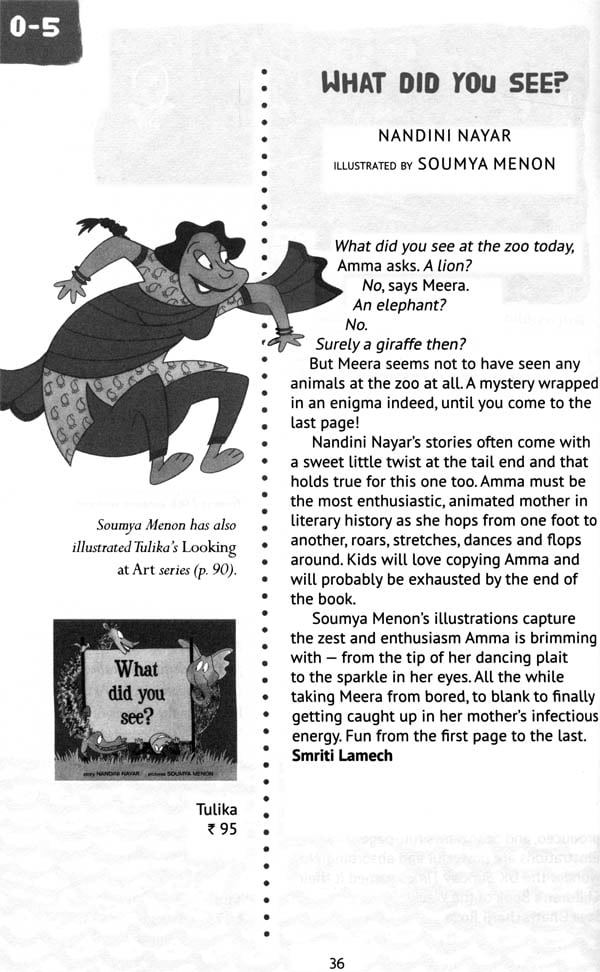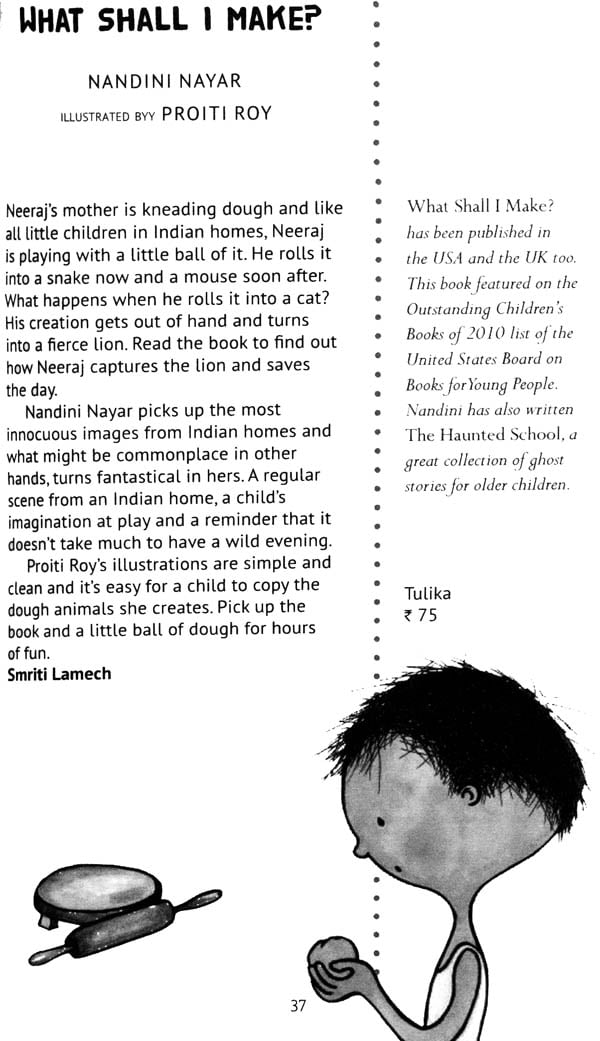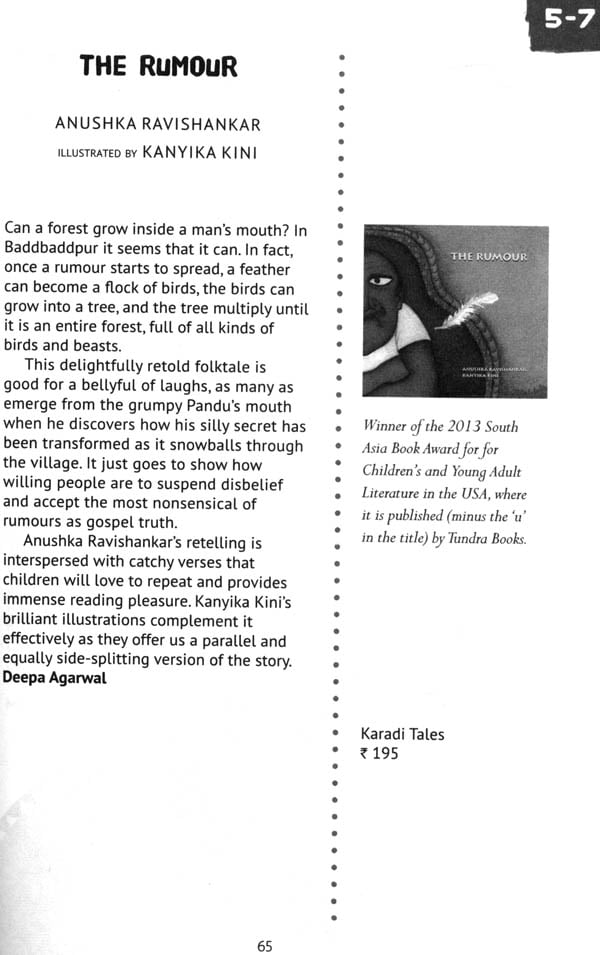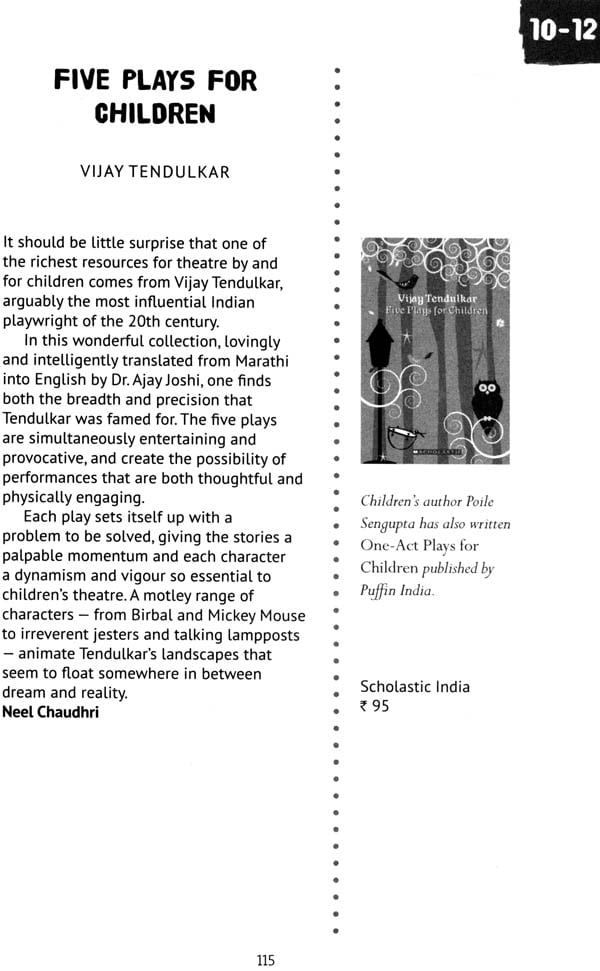
101 Indian Childrens Books We Love
Book Specification
| Item Code: | NAK980 |
| Author: | Anita Roy and Samina Mishra |
| Publisher: | Zubaan Publications |
| Language: | English |
| Edition: | 2013 |
| ISBN: | 9789381017104 |
| Pages: | 164 (Throughout B/W Illustrations ) |
| Cover: | Paperback |
| Other Details | 8.5 inch x 5.0 inch |
| Weight | 160 gm |
Book Description
I grew up with a mother who was a voracious reader and we had a huge bookshelf with a daunting display of books. She also satiated her appetite at the British Council library, that I would be dragged to every so often, on a sultry summer afternoon - a gray, unattractive and too silent place.
I was the third and youngest child - and it was possible that by the time I arrived all the energy of reading bedtime stories etc was drained out of my poor mother. Instead, she used to tell and retell the stories of Shakespeare's plays at bedtime, which I used to love. And still do!
Like many kids, both then and now, I didn't take to books like a fish to water. Sure, I read the few books my mother gave me, and I loved the worlds that they transported me to - The Secret Garden by Frances Hodgson Burnett, authors like Paul Gallico, Rumer Godden, and Gerald Durrell. But I was never a voracious reader, and I would envy my school friends who seemed to devour entire books in a single sitting.
The bizarre thing is that as an adult, when I walk into a bookshop I immediately head towards the children's section - and what a joy this is! I have a ten-year-old son who I have enjoyed reading to ever since he was a tiny tot. Now, of course, he reads to himself (although I am still, occasionally, allowed that honour).
What a delicious feast one has to chose from today. Nothing like this existed when I was a child. Indian tales from every corner of the country published beautifully, along with a fascinating selection of stories from across the world.
This book is a treasure trove for mums and dads and anyone who is interested in children and what they could read. What is most fabulous is its user friendliness. I know I need this book now more than ever before, to help me find the right books for my son as he grows into young adulthood, finding his own way in this world of literature, away from the paths that I have trodden before him, to forge off on his own voyage of discovery.
It's a thrill for me to find that my son is familiar with 50% of the books in the first half of the guide. But it is after the age of ten that real help is needed. And help is right here in the pages of 101 Indian Children's Books We Love!
Thank you, Young Zubaan, for this gem of a book. And for me so very timely!
"Can you recomend any good Indian books for children?" Parents and teachers often lament that they really want to buy and give Indian books to their kids, but just don't know what's out there. Information is patchy, bookstores are few and far between, and indifferently stocked, reviews of new books are virtually non-existent: where do you start?
Well, you're reading this guidebook, so that's a clue!
More often than not, we fall back on our own favourites from our childhood - Enid Blyton, or those 'timeless classics: like Tom Sawyer. Of course, there's nothing wrong with that: on the contrary, one of the great joys of parenting is to introduce your child to books that you had loved as a child yourself. Or parents stick with 'tried and tested' names, who have earned their trust by appearing so often on school syllabi and 'recommended reading' lists. A safe option but not, perhaps, a very adventurous one.
Or the kids themselves will lead the way, gleefully jumping on the bandwagon of what their friends are reading - Rick Riordan's Percy Jackson series, Stephanie Meyer's Twilight, or the grandmummy of them all, Harry Potter. All of which is fine but kids also need stories from the world around them - stories about kids like them, in settings that they recognise as their own. Ever wonder why the characters in your childrens' school essays always have Western names? Perhaps because the only Indian characters they have encountered are those in the Panchatantra! So, while we staunchly believe that kids should read good books from all cultures, we do think that Indian children's books should find an important place on kids' bookshelves. And Indian writers, illustrators and publishers have been working hard at bringing both contemporary and historical stories from India's diverse contexts to children. But how to bridge the gap between books and readers?
. By far the most effective recommendation is a friend grabbing your hand, thrusting a book in your face, and saying - with that slightly insane look of the newly-in-love - "Oh boy, you just have to read this!"
We hope that this book will act as something like that mad friend: a little in love, a little crazed, wildly enthusiastic.
Putting together a book like this was an uphill task.
Initially, we wanted to include books in languages other than English, but we realised that would be impossible within the relatively restricted space that we had. So we have focussed on books in English, including bilingual books and books in translation, and tried our best to ensure (with the usual caveats) that all the books listed are currently in print. To give a flavour of children's literature from other languages, we asked four experts to write essays on Hindi, Bengali, Malayali and Marathi books and authors, and to give us their recommendations.
We have not included school textbooks and educational books, although non-fiction books are very much there. We also decided - after much debate - to steer clear of mythologicals. There are so many versions of the Ramayana and Mahabharat out there, that this embarassment of riches would have taken us well beyond our self- imposed limit of 101.
After struggling to put together The Definitive List As Approved By Experts, we soon realised that not only was this a fool's errand it was not even what we really wanted. We wanted enthusiastic recommendations not quasi-scientific findings, so we ditched the words 'best', 'essential', 'ultimate' from the title, and went, instead, for 'love:
But does that mean that anything got in?
Well, surprisingly - or, actually, not - the books that people love, tend to be the ones that are well constructed, beautifully written, evocatively illustrated, and not full of grammatical errors. We consulted widely on the selection, and found a considerable consensus. Our role then became one of 'curating' rather than selecting. Our reviewers come from across the country and from many walks of life: the one thing that unites them is their love of books.
Books are windows to ideas and so as we began sifting through what to list, it became clear to us that we needed to talk about some of the ideas that are connected to children's books. In this first edition, we have taken up two: early childhood reading and bilingual books, both vital topics here in India. Our country has a rich oral tradition and for generations, children have grown up listening to stories told by the adults around them. But with new family structures and technology transforming that tradition along with a pressing need to eradicate illiteracy, we do need to think about when and how to introduce books to kids. Again, for a country that has 34 regional languages, not including Hindi and English, it is important for us to consider how we use language to recognise and encourage diversity.
We also felt that there were some writers whose impact on Indian children's literature across the years was too immense to be restricted to a single entry. Thus, there are essays on Ruskin Bond, Satyajit Ray and [im Corbett and we hope future editions will feature many more such writers.
The books in this guide do not constitute an exhaustive list, not by a long shot! Some people will be horrified that we've missed out their favourite book, and others might argue that some books we have included shouldn't be there at all. We're well aware that books - and somehow, particularly children's books - are an emotive subject. This guidebook is intended, at best, to provide a first stepping stone. If booksellers use this as their initial list to stock their shelves, well, then it's not a bad place to start. If parents searching for particular books find others along the way, then so much the better. If librarians and teachers discover new treasures in these pages, we hope that they will share those with their children and peers.
Alongside the main entries, weve tried to give useful, interesting or helpful information - about the author, the illustrator, publisher, or other books in this genre. (Confession: this was also a sneaky way for us to include many more wonderful books, while apparently still sticking to the magic number, 101.)
This guidebook is, like life, very much a work-in-progress. We hope to bring out regularly updated editions, and if you have thoughts about books that we really must include, we'd love to hear from you.
Contents
| Foreword | 7 | |
| Introduction | 9 | |
| Acknowledgments | 13 | |
| Books and Early childhood, Wendy Cooling | 15 | |
| 0 – 5 Years | 19-39 | |
| Why Bilingual Books Matter, Radhika Menon | 32 | |
| Hindi Children's Literature, Manisha Chaudhry | 40 | |
| 5 – 7 years | 45-75 | |
| Tuskin Bond, Aparna Ghosh Dastidar | 62 | |
| Malayalam Children's Literature, Rubin Dcruz | 76 | |
| 7 – 10 Years | 81-105 | |
| Satyathit Ray, Subhadra Sen Gupta | 92 | |
| Bengali Children's literature, Abhijit Gupta | 106 | |
| 10 – 12 years | 110-131 | |
| Jim Corbett, Teena Amrit Gill | 118 | |
| Marthi Children's Literature, Ashutosh Potdar | 132 | |
| 12+ years | 137-153 | |
| Select listing of children's publishers in India | 157 | |
| Some Blogs and websites that We Love | 162 |











